You've likely encountered suede's distinctive napped texture in luxury fashion items or upscale furniture, but there's more to this material than meets the eye. Suede undergoes a specific splitting and finishing process that creates its signature soft, velvety surface. While it's often confused with standard leather, suede's unique manufacturing method and characteristics set it apart as a specialized textile that demands particular attention - especially when it comes to its care and maintenance.
Key Takeaways
- Suede is a soft, napped fabric made from the underside of animal hides, primarily from lamb, calf, goat, or deer skin.
- The fabric undergoes specialized manufacturing involving hide treatment, tanning, and careful splitting to achieve its characteristic texture.
- Both natural and synthetic varieties exist, with natural suede offering premium quality and Ultrasuede providing easier maintenance.
- Suede requires special care as it's vulnerable to water damage and staining, needing specific brushes and cleaning products.
- The material is versatile, commonly used in luxury clothing, footwear, accessories, and high-end furniture upholstery.
Understanding Suede Fabric
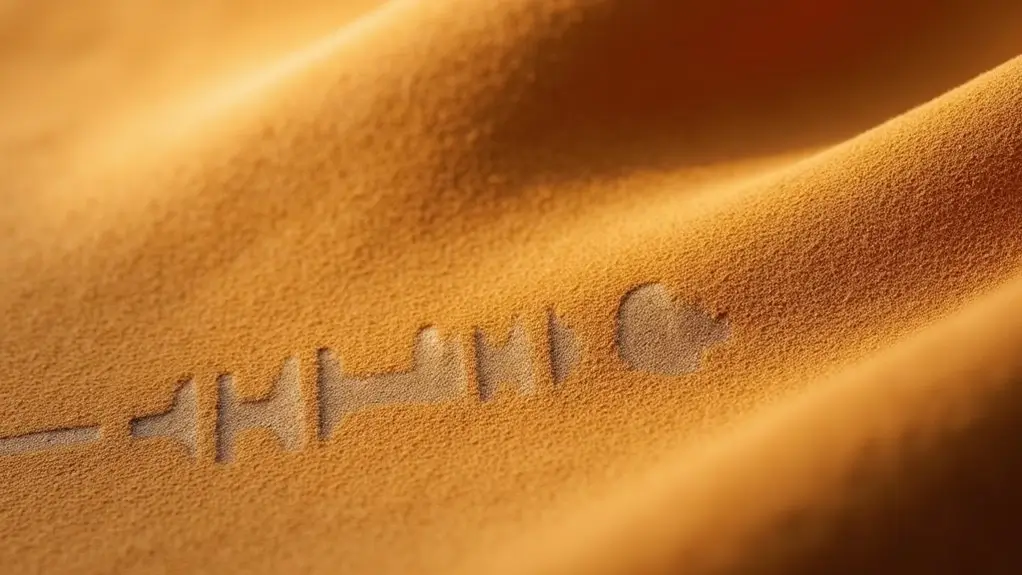
Suede fabric is a specialized leather material derived from the fibrous underside of animal hides, most commonly sourced from cow, lamb, calf, goat, or deer skin.
You'll find that suede's distinctive napped finish and soft texture result from a complex manufacturing process involving hide preparation, tannin treatment, and specialized splitting techniques.
The production sequence transforms raw animal hide into suede through multiple stages: initial drying, hair follicle removal using lime solutions, tannin application for preservation, and finally, precise splitting to achieve the characteristic fuzzy surface texture. Suede is made from the underside of the hide, making it a unique type of fabric in the leather family.
What is Suede?
A luxurious and distinctive textile, genuine suede is produced from the underside (flesh side) of animal hides, mainly sourced from sheep, calf, goat, or deer skin.
You'll find natural suede characterized by its unique napped finish, which creates its signature soft texture and matte appearance.
- Features exceptional softness compared to regular leather
- Requires specialized care due to its delicate nature
- Less resistant to water and stains than standard leather
- Available in both natural and synthetic varieties for different durability needs
While natural suede offers unmatched elegance, synthetic suede fabric provides a more affordable, durable alternative that mimics the authentic material's desirable properties. Understanding the difference between suede and other materials is essential for choosing the right fabric for your needs.
How is Suede Made?
Manufacturing genuine suede involves a complex sequence of steps that transform raw animal hide into the luxuriously soft material you see in finished products.
The type of leather undergoes initial processing where the hide is dried and treated with lime to remove hair follicles. Next, tannins are applied to stabilize the material, followed by treatments with salts and oils for enhanced durability.
Suede production then focuses on creating its signature texture through careful splitting and thinning of the hide's underside. The final stages may include dyeing and optional waterproofing treatments to complete the suede-making process.
Different Types of Suede
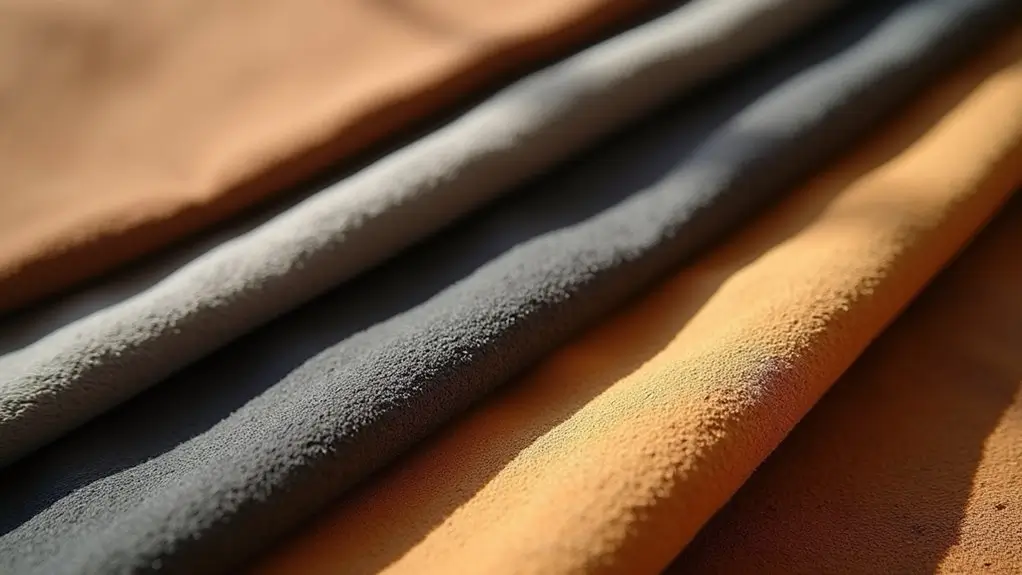
You'll encounter five primary types of suede in today's market: natural suede from animal hides, Ultrasuede (a polyester-based microfiber), Alcantara (a premium synthetic alternative), sueded silk (created through mechanical brushing of silk fabric), and sueded cotton (produced by napping cotton fibers).
Each type offers distinct performance characteristics, with natural suede providing the classic soft nap and breathability, while synthetic versions deliver enhanced durability and easier maintenance.
The manufacturing processes vary greatly, from traditional leather tanning methods for natural suede to advanced polymer engineering for synthetic alternatives, resulting in different price points and applications.
Suede
Several distinct types of suede exist in today's market, each offering unique characteristics for specific applications. When you're choosing a suede type, you'll need to evaluate its intended use and care requirements.
- Natural suede is a type derived from animal skin, typically lamb, calf, or deer, offering premium texture and breathability.
- Synthetic alternatives like Ultrasuede provide a durable option that's easier to care for and more resistant to water.
- Split suede comes from the lower layer of leather, creating a more affordable yet authentic material.
- Nubuck suede features a finer nap and denser construction, making it more resistant to wear.
Ultrasuede
Among synthetic suede varieties, Ultrasuede stands as a pioneering textile developed in Japan during the 1970s.
Unlike genuine suede, it's crafted from ultra-fine synthetic fibers that undergo a complex splitting process, creating a material that's more durable and easier to maintain than its natural counterpart.
You'll find that Ultrasuede offers significant advantages: it's resistant to water, stains, and fading while maintaining a suede-like texture.
Its environmental impact is lower than traditional suede fabric production, as it doesn't require animal products.
The material's durability makes it ideal for upholstery, automotive interiors, and fashion accessories where regular wear is expected.
Alcantara
Alcantara represents a high-end synthetic suede material, originally developed in Italy during the 1970s through a complex microfiber manufacturing process. You'll find that while suede is generally produced from animal hides, this synthetic alternative offers superior durability and environmentally friendly characteristics.
- Manufactured using polyester and polyurethane microfibers
- Features a three-layer composite structure for enhanced strength
- Offers 68% higher abrasion resistance compared to natural suede fabric
- Maintains color consistency and resists fading under UV exposure
The material's advanced properties make it particularly suitable for luxury automotive interiors, high-end furniture, and premium fashion accessories where performance meets sophistication.
Sueded Silk
Sueded silk represents a specialized textile that combines the luxurious properties of silk with a brushed, suede-like texture.
Unlike traditional suede fabric derived from soft leather, this material undergoes a mechanical brushing process that creates a napped surface on pure silk fabric. You'll find it's more environmentally friendly than animal-based suedes or synthetic alternatives, as it uses natural silk fibers.
The brushing technique breaks down the silk's smooth surface, creating a unique texture that mimics genuine suede's characteristic feel while maintaining silk's inherent qualities of breathability and lightweight comfort.
Sueded Cotton
The mechanical brushing process transforms ordinary cotton fabric into sueded cotton, creating a soft, peach-like texture that resembles genuine suede leather. This synthetic alternative delivers impressive softness and durability through specialized manufacturing techniques.
- Napping machinery raises cotton fibers to the surface using rotating cylinders with metal bristles.
- Double-sided brushing creates uniform texture on both sides of the fabric.
- Chemical treatments enhance the fabric's resistance to pilling and wear.
- Heat-setting stabilizes the raised fibers for long-term texture retention.
You'll find sueded cotton in casual wear, bedding, and upholstery applications where you want suede fabric's aesthetic without its maintenance requirements or cost.
Advantages of Suede
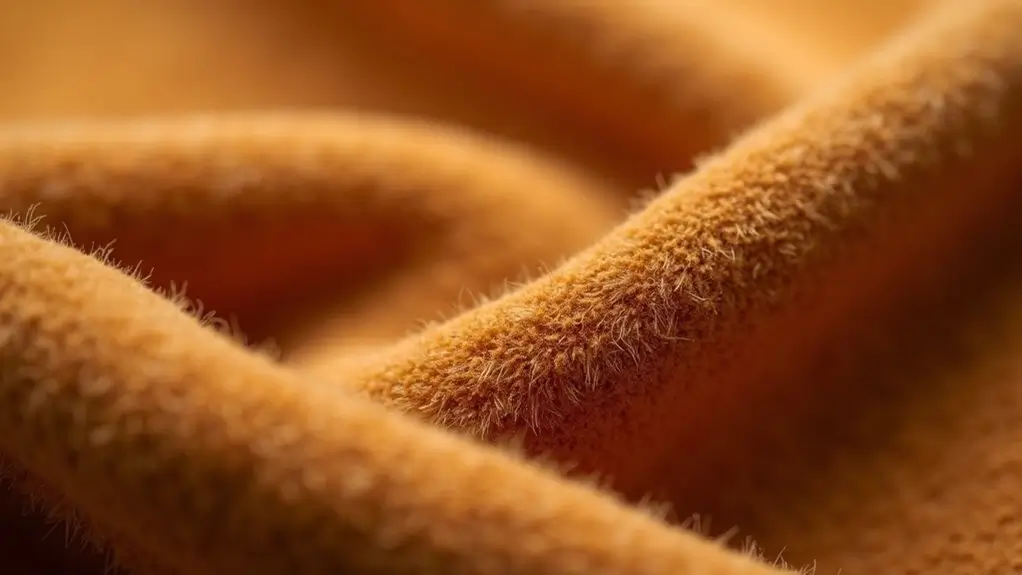
You'll find suede's aesthetic appeal derives from its distinctive napped finish, which creates a rich visual depth and luxurious matte appearance.
The material's flexibility allows it to conform to complex shapes while maintaining structural integrity, making it ideal for both apparel and accessory applications.
Suede's soft, brushed surface provides superior tactile comfort against skin, with natural temperature regulation properties that enhance its wearability across various climate conditions.
Aesthetic Appeal
Known for its distinctive napped finish, suede's aesthetic appeal stems from its luxuriously soft surface texture and rich visual depth.
You'll find this high-end material elevating the appearance of clothing and accessories through its unique characteristics:
- Matte finish that creates sophisticated depth and dimension
- Tactile napped surface that catches light differently from various angles
- Uniform texture that maintains consistent visual appeal across the fabric
- Natural color variations that add depth to dyed suede fabric
The material's refined appearance makes it a sought-after choice for premium fashion items, where its distinctive surface characteristics create an unmistakable mark of luxury and sophistication.
Comfort and Flexibility
Suede's inherent properties deliver exceptional wearing comfort and mobility across various applications.
You'll find its flexibility particularly noticeable in garments, where the material moves naturally with your body without restricting movement. The napped finish creates a highly breathable surface that adapts to your skin temperature.
The material's softness comes from its unique splitting process, which exposes the dermis layer's natural fiber structure.
While durable enough for regular wear, suede maintains its suppleness throughout its lifetime. This combination of strength and pliability makes it an ideal choice for products requiring both comfort and longevity, from footwear to accessories.
Disadvantages of Suede
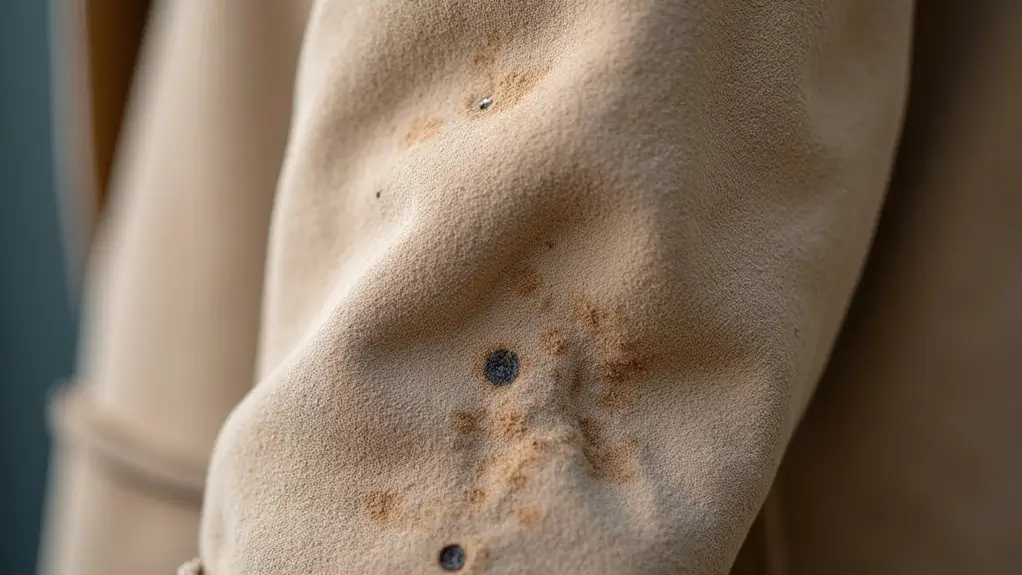
When you're working with suede, you'll find its durability markedly compromised by its vulnerability to water damage, scuffing, and staining due to its napped texture.
You'll need to invest considerable time in routine maintenance, including specialized brushing techniques and protective treatments to preserve the material's appearance and texture.
The fabric's susceptibility to permanent damage from improper cleaning methods means you'll require professional cleaning services, which adds to the overall cost of ownership.
Durability Concerns
Despite its luxurious feel and appearance, suede fabric presents several significant durability challenges that limit its practical applications.
Suede is highly susceptible to environmental damage, requiring extensive maintenance to preserve its quality.
- You'll find that suede's napped texture traps dirt and debris easily, making regular cleaning essential.
- The material isn't water-resistant, and exposure to moisture can cause permanent staining and texture changes.
- Without proper care, the fabric's delicate fibers can become matted or worn, especially in high-friction areas.
- UV exposure can cause fading and deterioration of the material's structural integrity.
These disadvantages of suede necessitate careful consideration before investing in suede items.
Maintenance Challenges
Maintaining suede fabric requires extensive time investment and specialized care protocols that many consumers find challenging to implement.
You'll need to regularly clean suede with a specialized suede brush to prevent matting and maintain its nap. The material's porous nature makes it easily damaged by water, oil, and everyday substances, requiring immediate attention to prevent permanent staining.
Even when you follow proper maintenance procedures, suede can still develop dark spots and discoloration.
Professional cleaning services are often necessary, as conventional washing methods can irreversibly damage the fabric's delicate surface structure and unique texture.
Applications of Suede Fabric
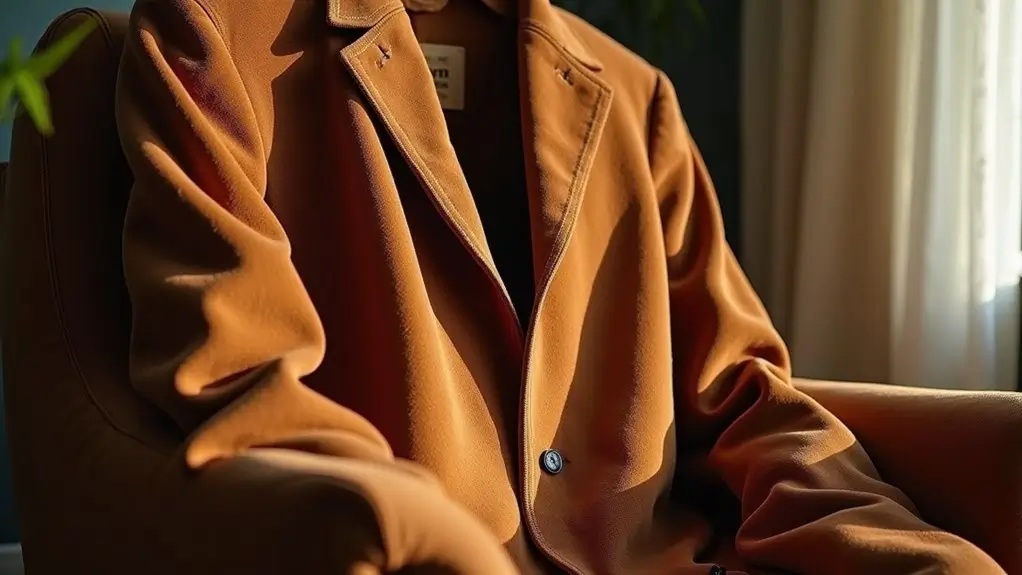
Suede's distinctive napped texture and soft hand feel make it an exceptional choice for high-end apparel items such as jackets, skirts, and dress pants.
You'll find suede extensively used in footwear manufacturing, particularly in dress shoes, boots, and casual loafers where its texture provides both aesthetic appeal and grip.
The material's versatility extends to accessories, where you'll encounter it in designer handbags, gloves, and belts that require the luxurious feel and visual appeal characteristic of suede.
Clothing
Many clothing applications showcase suede's distinctive napped texture and luxurious hand-feel.
You'll find different types of suede integrated into high-end garments where durability meets sophistication. While suede fabric is durable, it requires careful maintenance to preserve its unique characteristics.
- Outerwear: Jackets and coats featuring split-grain leather construction
- Footwear: Suede shoes ranging from dress boots to casual moccasins
- Accessories: Gloves, belts, and handbags that make clothing and accessories more luxurious
- Trim Elements: Decorative patches and elbow patches where suede feels enhance garment appeal
The material's adaptability allows designers to create both statement pieces and subtle accent elements in fashion applications.
Footwear
Footwear manufacturers frequently select suede for its unique split-grain texture and superior grip characteristics.
You'll find suede's distinctive properties particularly evident in dress shoes, where the material's softer nap provides both comfort and elegance.
The split leather hide creates a surface that's more flexible than traditional leather, making it ideal for both casual and formal footwear designs.
While natural suede requires careful maintenance to prevent water damage and staining, synthetic suede alternatives offer increased durability and weather resistance.
Many designers combine suede panels with other materials to create shoes that balance aesthetics with functionality.
Accessories
Beyond footwear, the fashion industry extensively implements suede across numerous accessory categories. You'll find both genuine and synthetic suede in high-end fashion accessories, requiring specific maintenance protocols to preserve their distinctive napped finish.
- Designer handbags featuring suede panels require regular cleaning with a specialized suede brush.
- Outerwear, particularly bomber and motorcycle jackets, benefit from suede's soft texture and matte appearance.
- Fashion belts incorporate suede backing for enhanced grip and aesthetic appeal.
- Luxury hat collections often utilize suede for its sophisticated texture and premium feel.
Professional care and proper storage are essential to maintain suede accessories' appearance and longevity.
Care for Suede
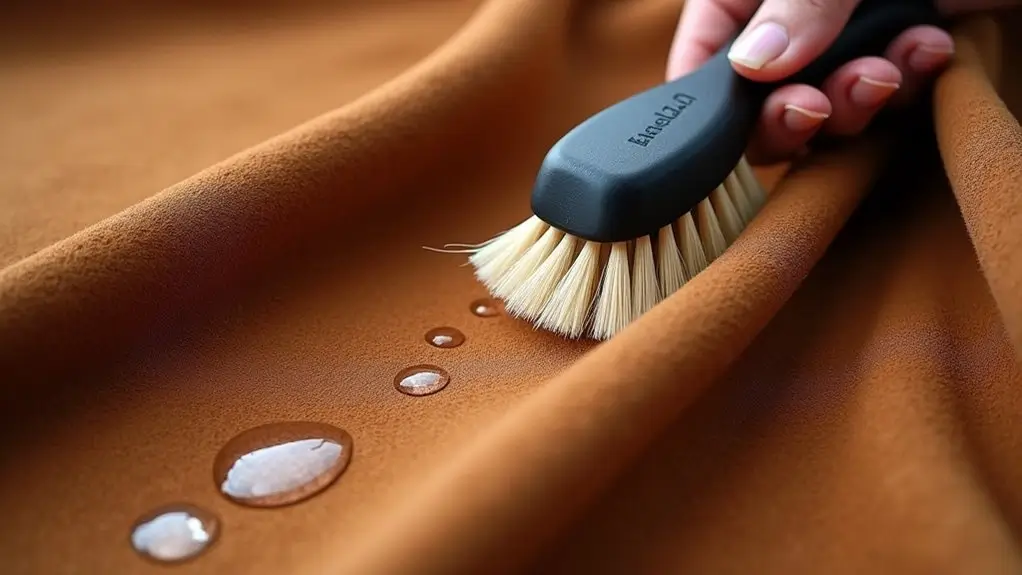
You'll need to regularly brush your suede with a specialized suede brush to maintain its nap and remove surface dirt.
When cleaning suede, you must use cleaning products specifically formulated for suede fabrics, as standard leather cleaners can damage the delicate napped surface.
To protect your suede from moisture damage, apply a water-repelling spray designed for suede before first wear and reapply periodically according to the manufacturer's specifications.
Cleaning Techniques
Proper suede maintenance requires specific cleaning techniques to preserve its delicate napped texture. Since suede isn't stain-resistant, you'll need to address spots immediately using appropriate methods.
- Use a specialized suede brush to remove surface dirt and restore the nap by brushing in one direction.
- Apply a suede eraser or rubber to gently lift stubborn stains without damaging the texture.
- Never attempt machine washing, as it will destroy the fabric's structural integrity.
- Seek professional cleaning services for deep stains or extensive soiling, as they'll use specialized solvents and techniques designed specifically for suede's delicate composition.
Tips for Maintaining Suede Fabric
Three fundamental principles guide effective suede maintenance: prevention, protection, and prompt response to damage.
To protect your suede, regularly use a suede brush to remove dirt and restore the nap. Apply waterproof spray specifically designed for delicate textile applications before first wear and reapply every few months.
When cleaning, work in one direction to maintain uniform texture. For synthetic alternatives, follow manufacturer-specific care instructions, as they're often more resilient than natural suede.
Keep your suede away from water and harsh elements. If it gets wet, stuff with paper towels and let it dry naturally at room temperature.
Never use heat or direct sunlight.
Frequently Asked Questions
Can Suede Fabric Be Successfully Dyed at Home After Purchase?
You shouldn't attempt home-dyeing suede fabric, as it requires professional-grade tannins and specialized chemical treatments. The material's napped surface and delicate composition make it highly susceptible to damage during non-industrial dyeing processes.
What's the Average Lifespan of Suede Compared to Regular Leather?
You'll find suede's lifespan is typically 3-5 years shorter than regular leather due to its napped surface structure and thinner composition. With proper maintenance, your suede items can last 5-7 years versus leather's 10-12 years.
Does Suede Stretch or Shrink Significantly Over Time With Regular Wear?
You'll notice suede's fiber structure allows moderate stretching with wear, particularly in high-stress areas. However, it won't shrink unless exposed to moisture and heat. Proper care maintains dimensional stability throughout its lifespan.
Can Vintage Suede Items Be Restored to Their Original Appearance?
Yes, you can restore vintage suede through professional reconditioning processes. You'll need specialized cleaning, nap restoration with brass brushing, and reapplication of protective treatments. However, you can't fully reverse severe water damage.
Are There Specific Weather Conditions That Permanently Damage Suede Beyond Repair?
Prolonged exposure to heavy rain and snow can permanently damage your suede's nap structure and cause irreversible fiber matting. Direct sunlight can fade dyes, while extreme humidity leads to mold growth and structural breakdown.
Conclusion
By understanding suede's properties and maintenance requirements, you'll optimize its performance in your applications. You're dealing with a split-grain leather that's undergone specialized napping processes to achieve its distinctive nap. While you'll need to implement protective treatments and specific cleaning protocols, suede's durability and aesthetic qualities make it a viable choice for both apparel and upholstery applications when properly maintained under controlled environmental conditions.


0 comments